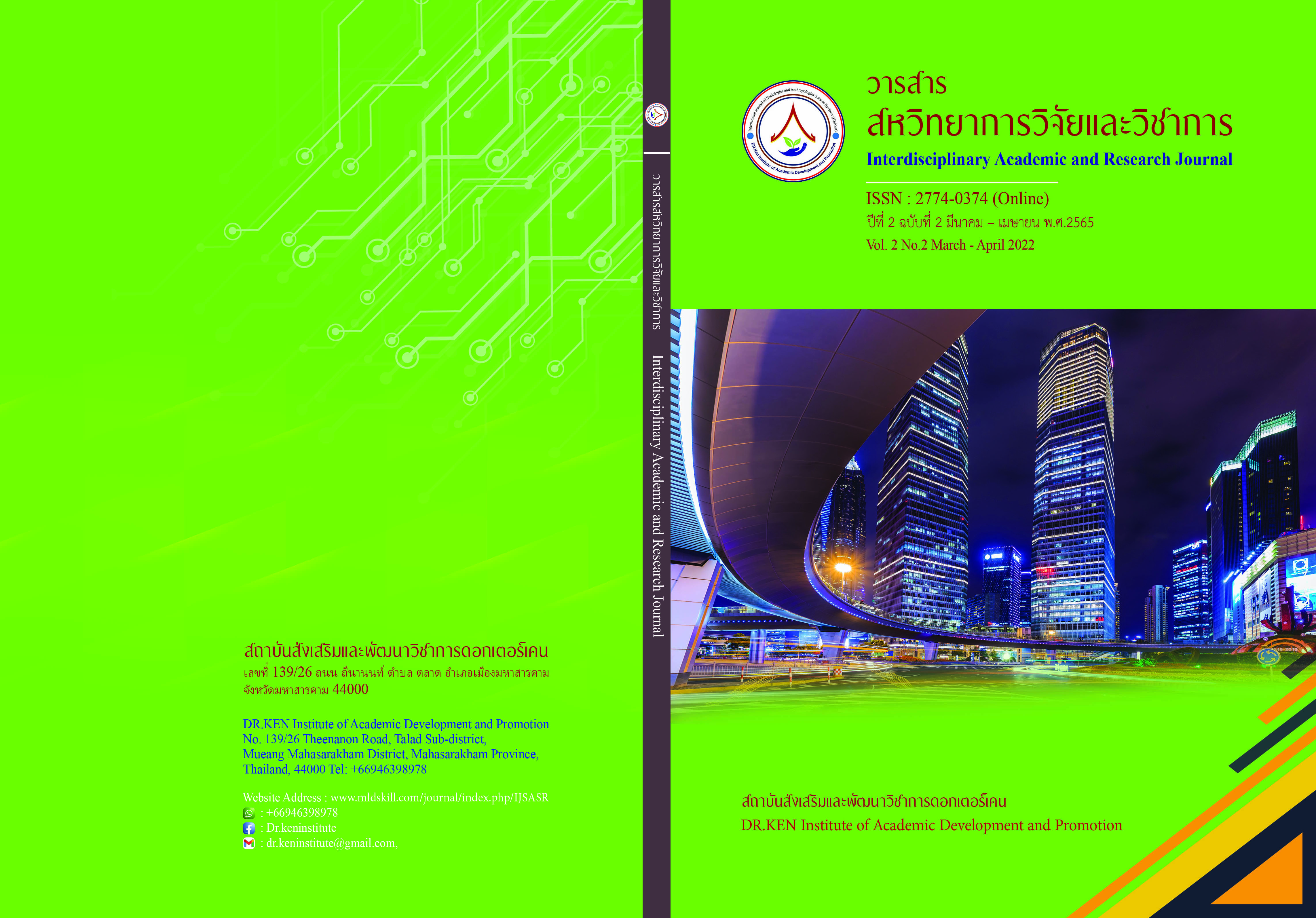การประเมินโครงการยกระดับผลสัมฤทธิ์ทางการเรียนโดยใช้รูปแบบการจัดการเรียนการสอนแบบเชิงรุกโรงเรียนบ้านโพนงาม สำนักงานเขตพื้นที่การศึกษาประถมศึกษาร้อยเอ็ด เขต 2 โดยใช้รูปแบบ CIPPIEST Model
DOI:
https://doi.org/10.14456/iarj.2022.13คำสำคัญ:
ประเมินโครงการ, รูปแบบการจัดการเรียนการสอนแบบ Active Learning, ยกระดับผลสัมฤทธิ์ทางการเรียนบทคัดย่อ
ผลสัมฤทธิ์ทางการเรียนเป็นสิ่งสะท้อนคุณภาพของผู้เรียนที่ผ่านกระบวนการจัดการเรียนรู้ทั้งที่เป็นทางการและไม่เป็นทางการซึ่งเป็นบทบาทของสถานศึกษาที่จะต้องออกแบบนวัตกรรมการจัดการเรียนรู้ที่มุ่งสู่การเพิ่มสมรรถนะการเรียนรู้ของผู้เรียนที่พึงประสงค์ การวิจัยครั้งนี้มีวัตถุประสงค์เพื่อประเมินโครงการยกระดับผลสัมฤทธิ์ทางการเรียนโดยใช้รูปแบบการจัดการเรียนการสอนแบบเชิงรุก โรงเรียนบ้านโพนงาม สำนักงานเขตพื้นที่การศึกษาประถมศึกษาร้อยเอ็ด เขต 2 โดยใช้รูปแบบ CIPPIEST Model ในด้านบริบท ด้านปัจจัยนำเข้า ด้านกระบวนการ ด้านผลผลิต ด้านผลกระทบ ด้านประสิทธิผล ด้านความยั่งยืน และด้านการถ่ายทอดส่งต่อ กลุ่มตัวอย่างที่ใช้ในวิจัย ได้แก่ ครูและบุคลากรทางการศึกษา จำนวน 6 คน ผู้ปกครองนักเรียน จำนวน 30 คน และนักเรียน จำนวน 23 คน รวมทั้งสิ้น จำนวน 59 คน ได้มาโดยการเลือกแบบเจาะจง เครื่องมือในการวิจัย ได้แก่ แบบสอบถาม แบบสัมภาษณ์ และแบบสังเกต สถิติใช้ในการวิเคราะห์ข้อมูล ได้แก่ ค่าเฉลี่ย ส่วนเบี่ยงเบนมาตรฐาน และการวิเคราะห์เนื้อหาผลการวิจัยพบว่า (1) ผลการประเมินโครงการในภาพรวม ตามความคิดเห็นของครูผู้สอน อยู่ในระดับมากที่สุด ความคิดเห็นของผู้ปกครองนักเรียนอยู่ในระดับมากที่สุด ผ่านเกณฑ์การประเมิน (2) ผลการประเมินโครงการด้านบริบท ด้านปัจจัยนำเข้า ด้านกระบวนการ ด้านผลผลิต ด้านผลกระทบ ด้านประสิทธิผล ตามความคิดเห็นของครูผู้สอน อยู่ในระดับมากที่สุด ความคิดเห็นของผู้ปกครองนักเรียนอยู่ในระดับมากที่สุด โครงการมีวัตถุประสงค์ เป้าหมายที่ชัดเจนเหมาะสม เนื้อหาและช่วงเวลาในการจัดกิจกรรมเหมาะสม และผู้บริหารเห็นความสำคัญ ให้การส่งเสริมสนับสนุนการดำเนินโครงการ การกำกับติดตาม ประเมินผล คลอบคลุมวัตถุประสงค์ เป้าหมายของโครงการ ขั้นตอน วิธีการประเมินผล มีความเหมาะสม และการจัดกิจกรรมตามโครงการมีความเหมาะสมกับนักเรียน นักเรียนมีความสนใจในการเรียนรู้ผ่านการการเรียนรู้ที่หลากลายและมีพัฒนาการทักษะการเรียนรู้ดีขึ้น (3) ผลการประเมินโครงการด้านการถ่ายทอดส่งต่อ ความคิดเห็นของครูผู้สอนอยู่ในระดับ มาก ความคิดเห็นของผู้ปกครองนักเรียนอยู่ในระดับมาก โรงเรียนควรประชาสัมพันธ์โครงการให้ผู้เกี่ยวข้องรับทราบด้วยวิธีการที่หลากหลาย โครงการสามารถเป็นแบบอย่างขยายผลให้กับโรงเรียนอื่นได้
เอกสารอ้างอิง
กมลรัตน์ ธิราวรรณ. (2561). สภาพ ปัญหา และผลสำเร็จของการดำเนินงานโครงการบ้านนักวิทยาศาสตร์น้อย ประเทศไทย ในโรงเรียนสังกัดสำนักงานเขตพื้นที่การศึกษาประถมศึกษาในจังหวัดสกลนคร. วิทยานิพนธ์ปริญญาการศึกษามหาบัณฑิต สาขาวิชาบริหารการศึกษา มหาวิทยาลัยราชภัฏสกลนคร.
ชนากานต์ อีกหาญ. (2558). การประเมิน. รายงานการประชุมวิชาการและนำเสนอผลการวิจัยระดับชาติและนานาชาติกลุ่มระดับชาติด้านการศึกษา. 3 (6), 116-126.
ปรีชาญ เดชศรี. (2545). การเรียนรู้แบบ Active Learning : ทำได้อย่างไร. วารสาร สสวท. 30 (116) : 53-55.
ไผท สิทธิสุนทร. (2543). การเรียนรู้แบบ 4 MAT. สานปฏิรูป. 24 (มีนาคม), 20-23.
มินดา เจริญภูมิ. (2559). การประเมินโครงการพัฒนาคุณธรรม จริยธรรมของนักเรียน โรงเรียนน้อยศึกษา สังกัดสำนักงานเขตพื้นที่การศึกษามัธยมศึกษา เขต 25 โดยประยุกต์ใช้รูปแบบ CIPPIEST. วิทยานิพนธ์ปริญญาครุศาสตร์มหาบัณฑิต สาขาวิซาวิจัยและประเมินผลการศึกษาบัณฑิตวิทยาลัย มหาวิทยาลัยราชภัฏมหาสารคาม.
เยาวดี รางชัยกุลวิบูลย์ศรี. (2556). การประเมินโครงการ : แนวคิดและแนวปฏิบัติ. กรุงเทพฯ : สำนักพิมพ์แห่งจุฬาลงกรณ์มหาวิทยาลัย.
รัตนะ บัวสนธ์. (2556). รูปแบบการประเมิน CIPP และ CIPPIEST มโนทัศน์ที่คลาดเคลื่อนและถูกต้องในการใช้. วารสารศิลปากรศึกษาศาสตร์วิจัย. 5 (2), 7-24.
รำไพ แสงนิกุล. (2559). การประเมินโครงการบ้านนักวิทยาศาสตร์น้อย ประเทศไทย : กรณีศึกษาสำนักงานเขตพื้นที่การศึกษาประถมศึกษากาฬสินธุ์ เขต 2. วิทยานิพนธ์ปริญญาครุศาสตร์มหาบัณฑิต สาขาวิชาวิจัยและประเมินผลการศึกษา บัณฑิตวิทยาลัย มหาวิทยาลัย ราชภัฏมหาสารคาม.
วิชัย วงษ์ใหญ่. (2525). พัฒนาหลักสูตรและการสอน – มิติใหม่. พิมพ์ครั้งที่ 3. กรุงเทพฯ:สุวีริยาสาส์น.
วิทูลย์ สุธรรมมา. (2557). การประเมินโครงการอำเภอควบคุมโรคเข้มแข็งแบบยั่งยืน จังหวัดมุกดาหาร.วิทยานิพนธ์ปริญญาสาธารณสุขศาสตร์มหาบัณฑิต สาขาวิชาการสร้างเสริมสุขภาพบัณฑิต วิทยาลัย มหาวิทยาลัยราชภัฏอุบลราชธานี.
สมคิด พรมจุ้ย. (2552). เทคนิคการประเมินโครงการ. กรุงเทพฯ: จตุพรดีไซน์.
สมนึก ภัทธิยธนี. (2551). การวัดผลการศึกษา. กาฬสินธุ์: ประสานการพิมพ์.
สุปัญญา ชาดง. (2561). การประเมินหลักสูตรจินตคณิต โดย CIPPIEST Model. วิทยานิพนธ์ปริญญาครุศาสตร์มหาบัณฑิต สาขาวิชาหลักสูตรและการสอน บัณฑิตวิทยาลัย มหาวิทยาลัยราชภัฏนครราชสีมา.
Bonwell, C. C., & Eison, J. A. (1991). Active Learning: Creating Excitement in the Classroom. ASHE-ERIC Higher Education Report. Washington DC: School of Education and Human Development, George Washington University.
Ha, R., Hussien, S., Wae-U-seng, N., & Hengpiya, A. (2017). Model of Factors Affecting Active Learning Behavior: Context of Three Southern Border Provinces of Thailand. PSAKU International Journal of Interdisciplinary Research, 6 (1), 103-110.
Vithayaporn, S., Katekaew, R., & Vorapanya, T. (2019). Changing the Role of a Lecturer to Improve the Student's Learning Outcomes. PSAKU International Journal of Interdisciplinary Research, 8 (2), 218-226.
ดาวน์โหลด
เผยแพร่แล้ว
รูปแบบการอ้างอิง
ฉบับ
ประเภทบทความ
สัญญาอนุญาต
ลิขสิทธิ์ (c) 2022 วารสารสหวิทยาการวิจัยและวิชาการ

อนุญาตภายใต้เงื่อนไข Creative Commons Attribution-NonCommercial-NoDerivatives 4.0 International License.
ลิขสิทธิ์ในบทความใดๆ ใน Interdisciplinary Academic and Research Journal ยังคงเป็นของผู้เขียนภายใต้ ภายใต้ Creative Commons Attribution-NonCommercial-NoDerivatives 4.0 International License การอนุญาตให้ใช้ข้อความ เนื้อหา รูปภาพ ฯลฯ ของสิ่งพิมพ์ ผู้ใช้ใดๆ เพื่ออ่าน ดาวน์โหลด คัดลอก แจกจ่าย พิมพ์ ค้นหา หรือลิงก์ไปยังบทความฉบับเต็ม รวบรวมข้อมูลเพื่อจัดทำดัชนี ส่งต่อเป็นข้อมูลไปยังซอฟต์แวร์ หรือใช้เพื่อวัตถุประสงค์ทางกฎหมายอื่นใด แต่ห้ามนำไปใช้ในเชิงพาณิชย์หรือด้วยเจตนาที่จะเป็นประโยชน์ต่อธุรกิจใดๆ

















